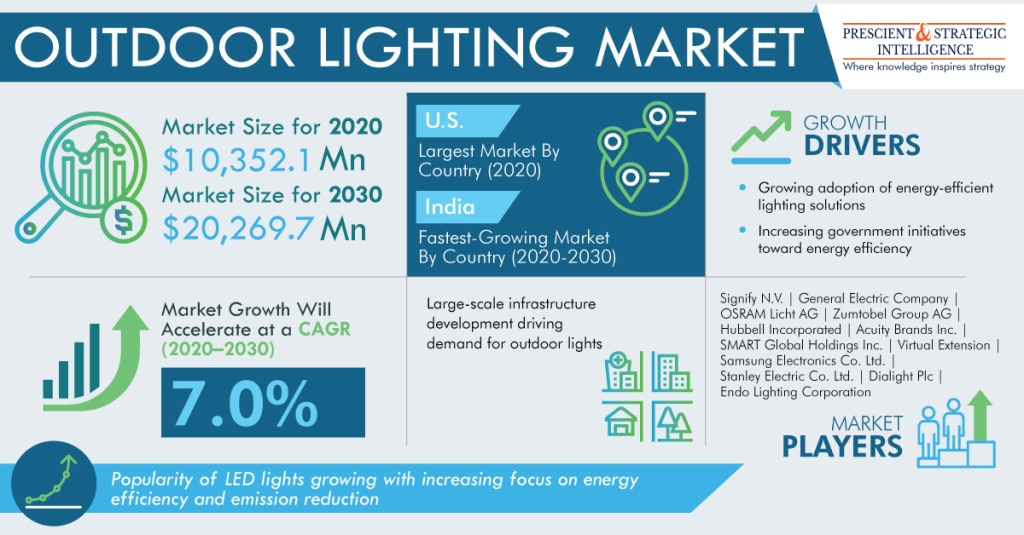In the U.S., from 2014 to 2016, the Outdoor Lighting Accelerator garnered an assurance to upgrade 1.3 million street lights, with the aim to save an estimated $48 million every year for each of the 25 partners, including 16 cities, three states, and six regional energy networks. Outdoor lighting consumes a lot of energy, approximately 1.3 quadrillion British thermal units every year, adding up to a total cost of nearly $10 billion every year, as per the U.S. Department of Energy.
Hence, with the rising preference for energy-efficient lights, the worldwide revenue of the outdoor lighting market was $10,352.1 million in 2020, and it is predicted to grow at a 7.0% CAGR during 2020–2030 and reach $20,269.7 million. Apart from the growing acceptance of energy-efficient lighting solutions, the rising number of government initiatives for energy efficiency and an increased investment in infrastructure, especially in urban and semi-urban areas, are credited for the growth of the market.

In the last decade itself, numerous municipalities started using LED technologies to reduce energy costs by about 50% over conventional lighting technologies and offer extra savings of 20 to 40% with smart controls. Apart from cost and energy savings, the higher effectiveness of LED lights offers benefits such as reduced carbon dioxide emissions, aiding cities to reach their goals of carbon reduction; decreased pollution by light, and better public safety due to enhanced visibility via better color rendition, and more-even distribution of the light.
The LED lights category reported the largest share in the outdoor lighting market in 2020, based on lighting type. It is further expected to be the fastest-growing category in the years to come. This can be credited to the rising penetration for LEDs as a source of light in numerous applications, for example, streets, parking spaces, and stadiums. Furthermore, LED permits the effective use of light intensity controls and enhances the potential for energy savings.
In recent times, in excess of 36.70 crore LED bulbs and 72.09 lakh LED tubes have been dispersed by the EESL all over India. This has brought about a projected savings of 47.98 billion kWh every year with an evaded peak demand of 9,747 MW, emission reduction of 39 million tons of CO2 equivalent every year, and projected annual savings of INR 19,156 crore on power bills. Dur to such advantages, LEDs for outdoor applications, such in parks, garages, and streets, is rapidly gaining popularity around the world.
APAC generated the highest revenue for the outdoor lighting market in 2020. This is credited to the rising adoption of smart LED lighting in the region, majorly under government initiatives. This region is correspondingly predicted to continue its dominance in the near future, because of the growing count of smart city projects in developing nations, such as China, South Korea, and India. Governments are also focusing on energy-saving through the usage of LED lighting on roads. The efficiency and low power consumption of LEDs are the important advantages that make them ideal for street lighting.
Hence, because of the presence of energy-efficient lighting solutions and increase in the number of government initiatives, the demand for smart outdoor lighting will rise further.

